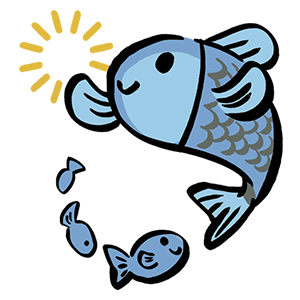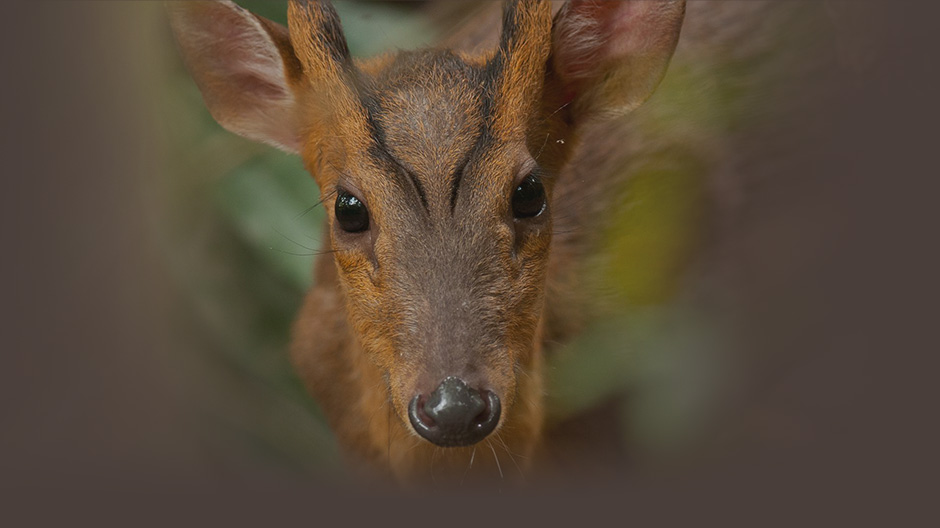海洋生態跨國科學家團隊發現:珊瑚礁魚類的幼魚會利用太陽方位與內在生理時鐘導航,找到回出生地的路。
體長僅數公釐的小魚利用研究者稱之為「日光導航」(sun compass)的能力,在大海中悠游不會迷失方向,並避免被捕食。
Mike Kingsford教授現為澳洲研究委員會(ARC,Australian Research Council)珊瑚礁研究卓越中心(Centre of Excellence for Coral Reef Studies)的成員,也任教於詹姆斯庫克大學。他解釋,珊瑚礁魚類孵化後會被海潮沖入大海,而後這些小魚必須找到回到出生地或鄰近珊瑚礁區的路。
Kingsford認為,「未能返回礁岩的幼魚將面臨死亡的命運。我們過去知道幼魚可利用聽力及嗅覺來定位並返回礁岩,現在我們證實,在他們小小的腦袋中也存在日光導航功能,可在白天利用陽光的位置定位,增強他們的定位導航能力。」
研究人員運用四線天竺鯛(Ostorhinchus doederleini)印證他們的理論。四線天竺鯛在西太平洋區是廣佈種,從台灣到紐西蘭Kermadec島,從日本到澳洲皆有其足跡。
他們使用澳洲大堡礁「孤樹島」(One Tree Island)的天竺鯛幼魚在塑膠游泳池內進行實驗。幼魚在幾秒之內便往南南東方向前進,即便研究人員轉動游泳池,幼魚仍往相同的方向前進。
Kingsford說明,「通常將幼魚帶離珊瑚礁的潮流會將牠們帶往北北西方向,因而幼魚必須朝南南東前進才能回到礁區。問題在於:幼魚如何得知方向並保持往該方向前進?」「雖然體型比許多昆蟲還小,幼魚卻有令人驚訝的游泳能力,且能承受海中潮流數日,隨之被帶往12公里或是更遠的地方。令人不解的是,在這個決定生死的旅程中,他們如何維持正確的方向?」
為了測試他們對日光定位的感知力,研究人員藉由將幼魚放入黑暗房間,以人工照明方式改變幼魚生理時鐘,將牠們的生理時鐘提前六小時。幼魚因而對日光位置產生誤判,自動的游往相反方向-北北西。
「由於他們被潮流帶到離原生礁岩太遠而不可能聽到或聞到原礁岩,這提供了他們運用日光在天際的移動來定位的有力證據。」他補充說,「這是一項許多人都無法達到的複雜任務,但珊瑚礁幼魚似乎毫無困難地完成了。」
研究者也在晴天與陰天分別測試幼魚的方向感,發現當陽光露臉時他們的導航能力更精準。他們還發現正午時分太陽在頭頂時,由於可提供資訊變少,幼魚的定向本能會變差。
研究結論指出,「這些測試證明這些魚類設有內部時鐘,牠們藉以用來校對日光導航以維持其朝南南東行進方向。」「由於校對時間是一種學習行為(因為太陽的方位會隨著季節及緯度轉換),這個學習很可能發生在早期散播階段,也就是幼魚被潮流待離出生地不久後。」
文中提到一些鳥類及海龜生來俱有方向感知能力,因此天竺鯛幼魚也有可能天生便具有朝向出生礁區南南東方向行進的能力。
這篇論文由Henrik Mouritsen、Jelle Atema、Michael J. Kingsford與Gabriele Gerlach共同發表,2013年7月刊載於開放下載的期刊「PLOS One」上,篇名為〈珊瑚礁魚類幼體藉由日光導航方向以返回出生礁區〉(Sun Compass Orientation Helps Coral Reef Fish Larvae Return to Their Natal Reef)。
Young coral reef fishes find their way back to the reef of their birth using the Sun and an internal body clock to steer by, an international team of marine scientists has discovered.
The tiny fish, no more than a few millimeters in length, avoid getting lost and eaten in the ocean and navigate their way to safety using what the researchers are calling a "sun compass."
When fish hatch on a reef they are swept away by currents into the open ocean. Then these tiny creatures must find their way back to the home reef, or another nearby, where they can settle in safety, explains Professor Mike Kingsford of the ARC Centre of Excellence for Coral Reef Studies and James Cook University.
"Failure to get back to a reef spells death for baby fish, and we've known for some time that they use their senses of hearing and smell to locate the reef and head back to it," said Kingsford.
"The fact that we've shown they also have a Sun compass in their tiny heads and can orient themselves according to the Sun's position through the day provides the missing link in their navigational toolkit," he says.
The fish with which the researchers tested their theory were four-line cardinal fish,Ostorhinchus doederleini, which are widespread in the Western Pacific, from Taiwan to the Kermadec Islands and from Japan to Australia.
They performed their tests using a small plastic swimming pool and baby cardinal fishes at One Tree Island on Australia's Great Barrier Reef. In a matter of seconds the juvenile cardinal fish turned and headed in a south southeasterly direction – and kept on heading that way even when the researchers turned their pool.
"The currents that sweep the baby fish off the reef generally set in a north-northwesterly direction, so to get back to it the fish have to swim south-southeast. The big question was: how did they know where that point of the compass lay, and keep to it?" Kingsford says.
"Though smaller than a good many insects, baby fish are surprisingly strong swimmers and they can push up against the current for several days, covering distances of twenty kilometers or even more," he said. "The mystery was how they maintained a correct orientation during this life-or-death journey."
To test their reliance on the Sun, the researchers "clock shifted" the little fish six hours back in time. They did this by putting the fish in a dark room and using artificial lights to reset their body clocks to a time six hours earlier.
The fish were fooled by the position of the Sun and began automatically to swim in an opposite direction – to the north-northwest.
"Since they are swept too far from the home reef to smell or hear it, this provides strong evidence they steer mainly by the Sun, making compensatory allowances as it moves across the sky," said Kingsford.
"This is a complicated task which quite a few humans would struggle to perform," said Kingsford, "but which baby coral reef fish seem to accomplish with few difficulties."
The researchers tested the fishes' orientation on both sunny and cloudy days, finding that they were more precise in their navigation when the Sun was out. They found the fishes' directional instincts were at their weakest around noon when the Sun was directly overhead, providing less information to steer by.
"The tests … demonstrate that the fish have an internal clock that they use as part of a time-compensated sun compass to maintain their south-southeast heading," the researchers conclude in their published paper.
"Since the time-compensation required for a sun compass needs to be learned (because the exact movement of the sun varies greatly with season and latitude)," the researchers conclude, "it is likely that this learning takes place during the early dispersal phase." (ie. soon after the fish larvae drift off their home reef.)"
They note that certain birds and sea turtles are born with an in-built sense of direction, and it is possible the baby cardinal fish, too, inherit the instinct to head south-southeast – back towards their home reef.
Their paper "Sun Compass Orientation Helps Coral Reef Fish Larvae Return to Their Natal Reef" by Henrik Mouritsen, Jelle Atema, Michael J. Kingsford and Gabriele Gerlach appears in the open access journal "PLOS One" of June 2013.
※ 全文及圖片詳見 ENS報導
 網站捷徑
網站捷徑



